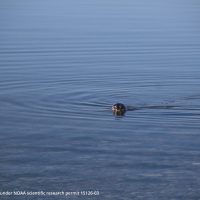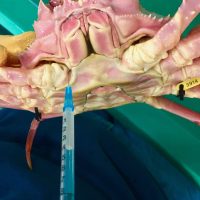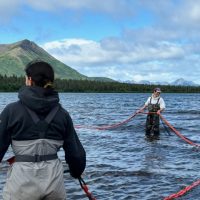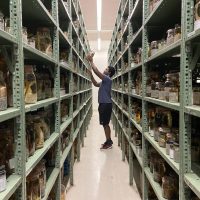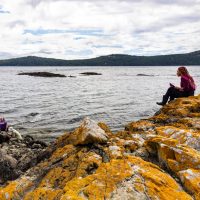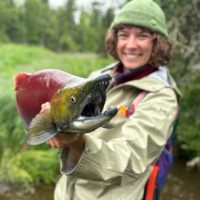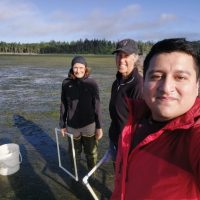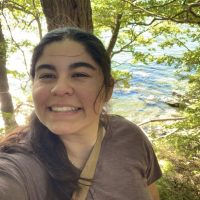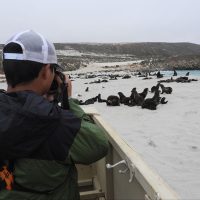Filter Results
One or many? Exploring the population groups of the largest animal on Earth
Hunted nearly to extinction during 20th century whaling, the world’s largest animal, the Antarctic blue whale, went from a population size of roughly 200,000 to little more than 300. The most recent abundance estimate in 2004 put Antarctic blue whales at less than 1% of their pre-whaling levels. But is this population recovering? Is there just one population of Antarctic blue whales, or multiple? Why do these questions matter for conservation? PhD student, Zoe Rand, is tackling these questions in a new study.
Read moreHarbor seals and fish parasites: How two undergrads contributed to major discoveries in cryptic diversity
Taking the AERA class as part of the Alaska Salmon Program was a pivotal moment for two undergrads, who went on to contribute to major discoveries in cryptic diversity in two vastly different species: harbor seals and fish parasites.
Read moreBitter crabs…attitude problem or parasitic infection?
Bitter crab syndrome might sound like an attitude problem, but it’s actually a condition faced by two very valuable fisheries in Alaska: snow crabs and Tanner crabs. So-called for the bitter flavor of crab meat in infected crabs, bitter crab syndrome (BCS) is caused by a parasitic dinoflagellate of the genus Hematodinium and infects a number of crustacean species around the globe. We spoke to SAFS grad student, Aspen Coyle, about her research.
Read moreCommunity and connection with the Alaska Salmon Program
It’s not all work while visiting the Alaska Salmon Program camps for the summer field season. Students head up to southwest Alaska, some for over three months, and downtime is a chance to explore, connect with their peers, and experience living in a field camp.
Read moreUncovering parasites in one of the world’s largest fish collections
Housed in a set of World War II artillery bunkers on the outskirts of New Orleans is a surprising, and gargantuan, fish collection. Home to the largest collection of post-larval fish specimens in the world – 7 million to be precise – the Royal D. Suttkus Fish Collection at the Tulane University Biodiversity Research Institute (TUBRI) was the destination for a group of UW researchers over the summer.
Read moreStudents get their hands dirty studying marine biology on Yellow Island, led by SAFS graduate student
Chris Mantegna, a third-year graduate student at SAFS, has spent the past three summers mentoring undergrads on on Yellow Island, a pristine 11-acre nature preserve in Washington’s San Juan Islands.
Read moreThe return of the sockeye: a summer with the Alaska Salmon Program
You may be familiar with the Alaska Salmon Program and its critical role in producing knowledge for managing and conserving regional ecosystems and their fisheries. But we’re doing a deeper dive into the role of students in the program, the opportunities for immersive learning, and the bonding experience with both fellow students and instructors during their time in Alaska.
Read moreHow do our sea-meadows grow?
The WSG-funded research informs the future of eelgrass restoration in Washington, and the study is headed by UW Professors Kerry Naish (SAFS) and Jennifer Ruesink (Biology), as well as SAFS doctoral student Bryan Briones Ortiz. Their research first looked at the baseline genetic structure of the eelgrass population in Washington.
Read moreNewly graduated SAFS master’s student chosen as 2024 WSG Keystone Fellow
Recent graduate of the SAFS master’s program, Jezella Peraza, has been chosen as the 2024 Washington Sea Grant (WSG) Keystone Fellow. As the 2024 WSG Keystone Fellow, Jezella will work with the Seattle Aquarium on an integrated conservation effort for pinto abalone. In collaboration with Indigenous Peoples and local communities, Jezella will help shape and implement engagement strategies to support pinto abalone recovery and honor cultural connections.
Read moreReal-world research as an undergraduate: studying pinnipeds on San Miguel Island with NOAA
In the most recent cohort of University of Washington (UW) students participating in the NOAA Marine Mammal Lab internship program organized through SAFS, Chris Moon spent the summer of 2024 working with Dr. Tony Orr from NOAA Alaska Fisheries Science Center (AFSC), studying northern fur seals and California sea lions on San Miguel Island, California.
Read more
